The Key Seven for Bicycle Riders
These stretches target the key muscles that tighten while cycling. The first three are muscles that are prone to cramping while bicycling. Stretching the muscles will lengthen them and reduce the probability of cramps on the bicycle. |
| Gastrocnemius and Achilles: The gastrocnemius and soleus muscles in your calf provide power from about 45° to 135° while cycling. The gastrocnemius is the large fleshy muscle that runs from behind your knee to your ankle. To stretch it stand with your left leg straight and your foot several feet away from a wall. Slowly lean toward the wall to stretch the left gastrocnemius and Achilles. Repeat to stretch the right leg. |

Gastrocnemius and Achilles stretch
demonstrated by Dan Kehlenbach
my co-author of Distance Cycling. |
| Quadriceps: The quadriceps are the fleshy muscles on the front of your thigh. They straighten the knee and provide power primarily through the first 90° of the stroke while cycling. To stretch the quadriceps lie on your left side with your left leg slightly bent. Bend your right leg until you can hold your right ankle with your right hand. Keep your pelvis forward and gently pull back until you feel your quad stretch. Repeat to stretch the other leg. |
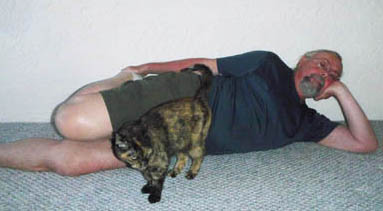
Quadriceps stretch with Phoebe
hoping I’ll pet her. |
| Hamstrings: The hamstrings provide power as you pull your foot through the bottom of the stroke on the bicycle. To stretch your hamstrings, lie on your back and bend your right knee so that your foot is flat on the floor. Hook a towel or strap over your left foot. Lift your left leg straight up toward the ceiling, keeping the knee joint straight, until you feel a gentle stretch in your hamstring. If you are more flexible you can do the stretch with your right leg straight on the floor rather than the knee bent. Then stretch the other leg. |
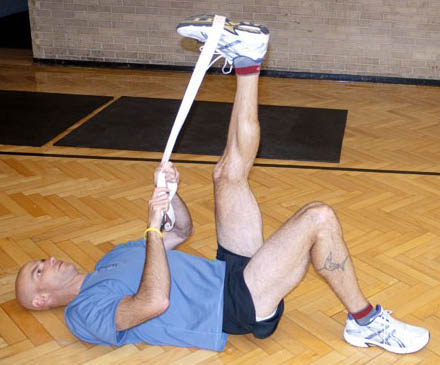
Hamstring stretch |
| Cat: Our backs often get tight after hours of bicycle riding. To stretch and relax, get on your hands and knees. Start the stretch by slowly arching your back up and rolling your head forward and dropping your chin down toward chest. Then reverse the stretch starting with your pelvis, then pushing your abdomen toward floor and finally rolling your head back slowly. Repeat the stretch several times taking about 30 seconds each time to go through the full range of motion each direction.
Our backs get particularly tight after bicycling up a sustained climb. You can stretch out your back carefully while riding on your bicycle. To stretch out, coast with your pedals in the 3 and 9 o’clock positions and keep looking down the road while you arch your back and then push your abdomen toward the top tube of your bicycle.
|
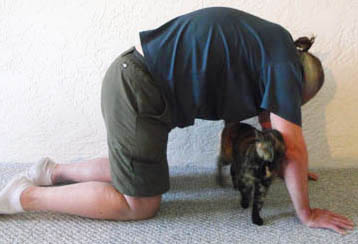
Phoebe helping me demonstrate
position 1 of the cat stretch |
| |
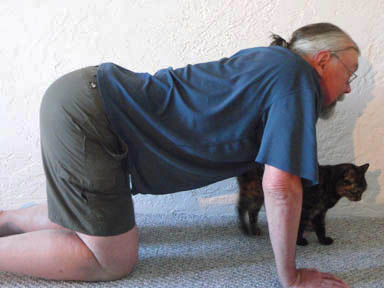
Position 2 of the cat stretch |
| Gluteals: The gluteals are the big muscles in your butt. They straighten the hip and provide power primarily through the first 90° of the stroke on the bicycle. To stretch the glutes lie on your back with your right leg bent and foot flat on the floor. Cross your left ankle over your right knee. Curl up, wrap your hands around your thigh and then lie back down. You’ll feel the stretch in your left gluteal. |
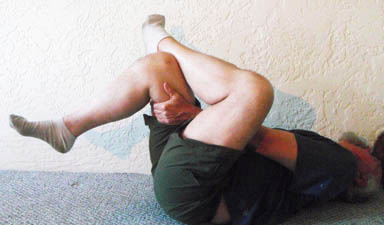
Gluteal stretch |
| Soleus: To stretch the soleus in your calf stand with your left leg bent about 20 degrees at the knee and your foot several feet away from a wall. Your right foot should be under your body closer to the wall. Slowly lean toward the wall to stretch the soleus muscle in your left calf. Repeat the stretch with right leg. |
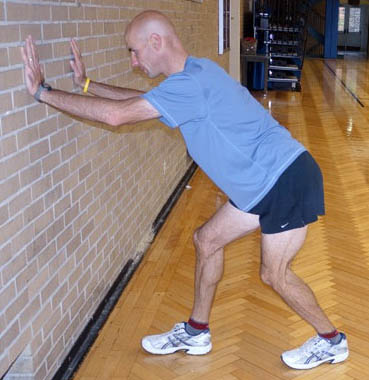
Soleus stretch |
| Hip flexor: The hip flexors are a group of muscles between the front of the hip and the thigh. On the bicycle they lift one leg through the back of the stroke so that your other leg doesn’t have to push the ascending leg up. To stretch them, lie on your stomach with a strap or towel hooked over your left foot. Pull on the strap lifting your left thigh slightly off the floor and you should feel a nice stretch in the left hip flexor/quadriceps. Repeat the stretch with other leg.
On a bicycle ride here’s an alternative stretch. Kneel with your left knee on the ground and right foot flat on the ground in front of your body. Your right knee and hip should be at right angles. Hold onto something for balance and push your pelvis forward while keeping your torso straight until you feel a stretch in the left hip flexor and quadriceps. |
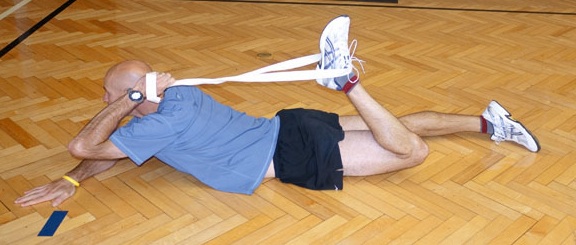
Hip flexors stretch |
Other Good Stretches
These stretches work on the other muscles that tighten while bicycle riding: |
| Overhead:Your back often gets tight from bending over on your bicycle. At home or at a rest stop interweave your fingers, reach overhead and push your palms toward the sky. Stretch and imagine your spine elongating. Then bend slightly to one side, hold, and then bend to the other side. |
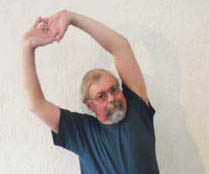
Overhead stretch |
| Neck: Our neck muscles often fatigue and tighten from holding up our head and helmets for hours while cycling. Stretch your neck three different directions:
First stand with your head rolled forward and your chin on chest. Put your hands on back of your head and allow weight of your arms to pull your head down and stretch the back of your neck. |
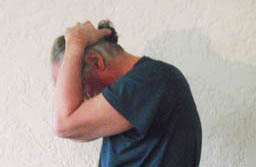
First neck stretch |
| To stretch the left side of your neck, roll your head towards your right shoulder. Wrap your right arm over top of your head and allow weight to pull your head to right and stretch your neck. For more of a stretch push your left palm toward the floor or ground.
Repeat the stretch for left side.
Never stretch your neck backwards; this may strain vertebrae. |
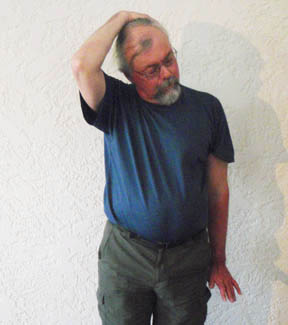
Second neck stretch |
| Chest: To open up and stretch your chest muscles, which tighten during hours hunched over the bars, grab a doorway or tree with one hand and rotate your torso away from that hand to stretch that side of the chest. Or bend your arm, rest your elbow and forearm against a wall and rotate away. Repeat the stretch on the other side.
| 
Chest stretch |
| Back rotation: To stretch out your back after a bicycle ride, sit with your right leg extended on floor. Place your left hand on floor behind you for balance. Bend your left leg and place your left foot on right side of your right knee. Then cross your right arm over in front of your left knee, and rotate your trunk to the left. Repeat the stretch to right side.
You can also do this with your bicycle: Stand with both feet on the ground, straddling the bike. Rotate to the right, grab your seat with your right hand and your stem with your left hand. Repeat the stretch to the left side.
|
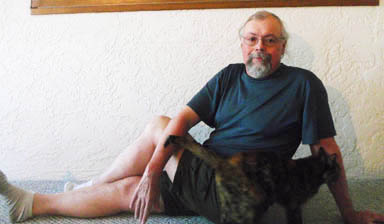
Back stretch |
| Groin: Your groin muscles help to hold your legs in alignment while cycling. To stretch them, sit with your knees together, bent about 90 degrees and the soles of your feet flat on the floor. Let your knees drop out to the sides and you’ll feel a stretch in your groin. You can increase the stretch by using your butt muscles to pull your knees closer to the floor or bending forward from the hips. |
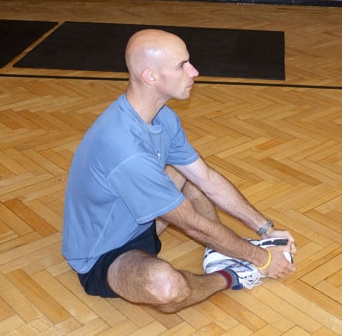
Groin stretch |
| Iliotibial Band (IT Band): The IT band is a sheath of connective tissue that runs along the outside of the thigh from the top of the hip bone to just below the knee. If it gets tight, while cycling you’ll feel a pain on the outside middle of the knee, starting with a mild pain and becoming sharper. To stretch the IT band, stand with the afflicted leg (in this case the right knee) near a wall and put your hand out to stabilize yourself. Cross the other (left) leg in front of the leg you are stretching and place that (left) foot 6-8 inches closer to the wall. Push the (right) hip with the afflicted knee toward the wall until you feel a stretch along the outside of your (right) hip and quad. |
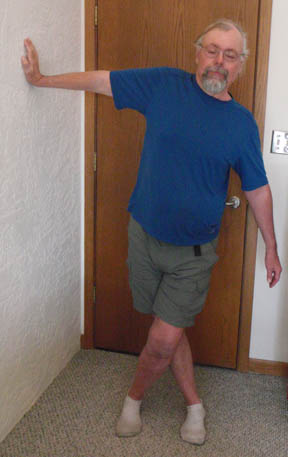
IT band stretch |
























